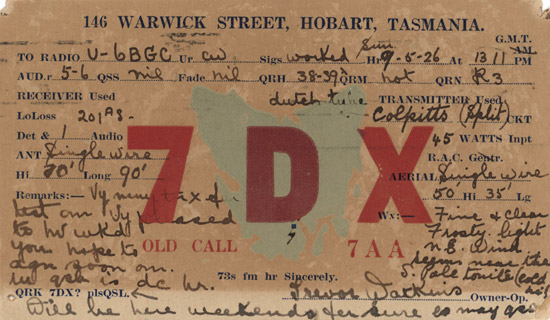

7DX 1926 Australia
Operator: William Trevor Watkins "Watty" 7AA, 7DX
In Australia in 1925, the
Australian regulator of the day, the Postmaster-General's
Department, decided that the amateur callsign suffix
"AA" would be reserved for departmental use, Australia
wide. Note that the callsigns 2AA and 3AA had already been
self-allocated to the PMGD in 1922, but not in other states. I
assume that this was to make transmissions by Departmental
officers readily identifiable by the amateur community at large
when they were being chastened by the Department while on-air.
The most notable affected amateur was our beloved William Trevor
Watkins "Watty" 7AA, Tasmania's first broadcaster from about 1922.
He would not have been happy to learn in 1925 that his 7AA
callsign, well known around Australia and the world, was to be
withdrawn. Perhaps to ease the pain, he was allocated the
excellent callsign 7DX, and Watty continued to cast a long shadow
over the amateur world until his untimely passing in 1931. A most
interesting piece of history recorded forever by QSL cards. The
only other AA callsign withdrawal that I am aware of was Bill
Bright, an early spark experimenter from preWW1. Bill changed his
call from 4FA to 4AA in 1924 only to have it taken away again in
1925 and being left with 4WB in lieu. Bill was a telegraphist
with the PMGD, so he likely sought out the 4AA callsign in a
semi-official capacity. In an interesting twist of this saga, Bert Grey 6BO was a senior
figure in WA's PMGD and often acted as State Radio Inspector in
the absence of George Archibald Scott.
In 1937, Bert gave up his 6BO callsign and was allocated the official callsign 6AA including for personal use, though he seems to have ceased personal amateur radio activity post WW2. Probably through oversight, the callsign VK1AA was allocated for a number of Antarctic operations in the early 1950s, until the VK1 prefix was brought into use for the ACT in the 1950s. A final twist was the apparent use in 1900 of the "AA" callsign by one of our earliest wireless experimenters, Henry Walter Jenvey. This was perhaps the first use of a wireless callsign in Australia. It can be argued that Jenvey was Australia's first radio amateur, as most of his wireless experimentation was self-funded.
QSL, Info courtesy of VK1DXA